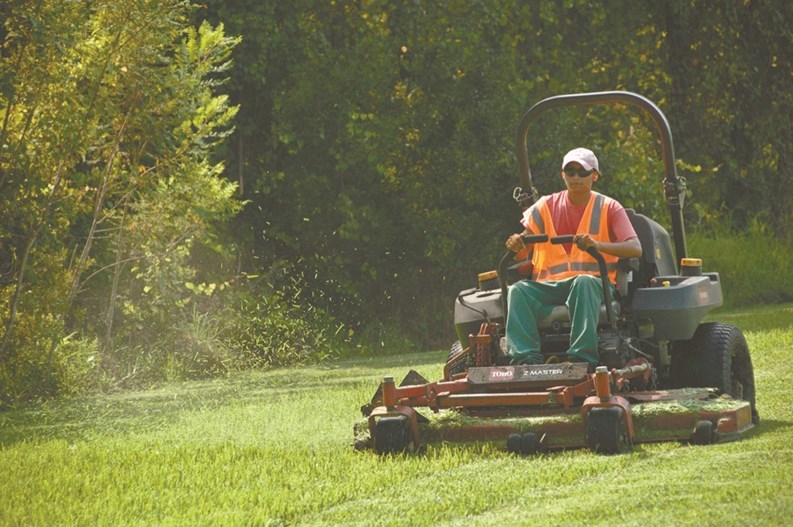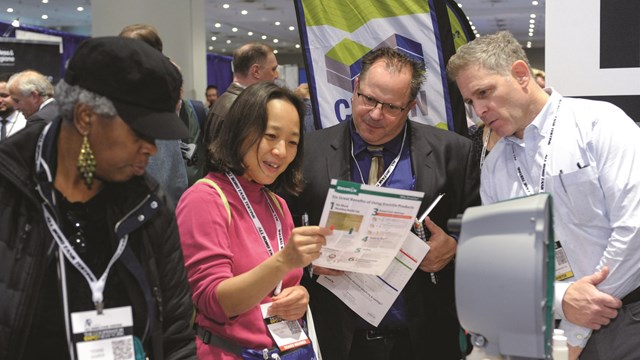Chicagoland is not exactly known for year-round sunshine and palm trees. At first glance, greenery, lawns and lawn care may seem to be non–issues for many city residents, but like most Americans, Chicagoans have a love affair with lush green turf.
Keeping grass green in Chicago’s widely-varying climate—where winter temperatures can average below freezing and summer months can bring triple-digit temperatures—can be a challenge. And don’t forget those frosty, winter blasts off of Lake Michigan that can wreak havoc on the healthiest lawn.
Condominium and homeowners associations often find landscaping and lawn care the largest line item in the budget after insurance. Landscaping also adds to a property’s real and perceived value, not only for current residents, but for those seeking a new address to call home. Nothing ups the ante on curb appeal quite like well-maintained landscaping and colorful plants.
Winter Greenery
Sean Wunderlich, a landscape designer at Medina Lawn Care in Chicago, says that only the hardiest, most durable grasses should be used for Chicago lawns. “The most common grass used on Chicago lawns is Kentucky Bluegrass mixed in with some other varieties,” he says. “The problem with Kentucky bluegrass is that it’s not very drought tolerant. It will survive a drought but it tends to go dormant in the summer and it’s not going to retain its green color unless it gets a lot of water.”
“The most common type of grass or ground cover in the Chicago area is a blend between fescue, rye and Kentucky bluegrass,” adds Suzanne Coventry, an account manager with ValleyCrest Companies in Schaumburg.
It’s Isn’t Easy
An attractive lawn doesn’t just happen overnight. It requires effort and maintenance. The problems associated with lawn upkeep in Chicago can be unique. Urban pollution, salt exposure and snow plow damage and other urban stresses here can present a whole different set of challenges compared to most other states.
“The top most common lawn problem that we deal with in the Chicago area is grubs, which are more of an insect issue,” says Coventry. “Grubs are the larvae form of the Japanese beetle and they chew on the roots of the lawn. That happens anywhere between the end of May to the beginning of June through September. You will know by the end of August if you have grubs. Your grass will look very brown and when you pull it, it pulls up from the roots because there’s no root system. You can peel it back like carpet. Another common problem we see in the spring is some of the powdery mildew and funguses, especially if it was a really wet spring — and last year, because of the drought we had issues in regards to more turf stress and we also saw a lot of chinch bug.”
Wunderlich says there are signs of serious lawn problems. “Sometimes a lawn can turn black, and that usually means there is a fungal infection,” says Wunderlich. “Sometimes grass will get powdery mildews. If you have a healthy lawn but there are patches of brown or dead spots, it could be anything from a dog going on it too much or it could be a sign of a serious problem. Fungus can attack a lawn if it gets too much water, or if the lawn is watered too late at night because the lawn doesn’t have time to dry and it tends to get cooler at night. Over a period of time, a lawn can develop a fungal infection from that.”
“Leaf spot can be a problem in the Chicagoland area,” says Adrian Medina, the residential maintenance account manager at Christy Webber Landscapes in Chicago. “It’s spots on the actual blades, it’s a fungus. The weather has something to do with it. Over-watering can also cause leaf spot. A lawn should take an inch to an inch and a half of water for the entire week for a nice green lawn. But the drought this past year was brutal on all turfs. Believe it or not, snow doesn’t damage grass, it acts as insulation. Snow doesn’t hurt grass, salting does.”
When it comes to weeding and feeding the landscape there are a host of environmentally-friendly products on the market. In the hands of a certified lawn care professional, these products will enhance the lawn and landscaping. At no time should an untrained person apply these products, since there are so many variables involved with a correct application.
“One of the most common mistakes people make when caring for their lawn is under-watering or over-watering,” says Medina. “You should understand the seasons. In the spring there is a lot of rain so you should lay off the watering a bit and let Mother Nature do her thing. In the summer months you want to regulate the watering. You should never water in the evenings because the water just sits there and it doesn’t evaporate until the next day and this can cause funguses. It’s good to water early mornings right before the sun comes out.”
“In the spring we recommend that you do something called de-thatching. We use a power rake and what you are doing is raking all of the dead grass that didn’t survive the winter,” says Wunderlich. “Grass is like any other plant; like a tree loses its leaves, individual stalks of grass will die, so during the spring when you de-thatch your lawn you’re reinvigorating it. It’s like you’re giving it a bit of a haircut. Some people also chose to core aerate their lawn during this time; that’s a machine that pokes a hole in the soil and allows the oxygen and water to get down to the roots.”
“Fertilizing is probably the most important thing a homeowner or groundskeeper can do to keep their lawn attractive and healthy, that’s our biggest thing,” says Coventry. “It’s not a ‘set it and forget it’ product. The best thing is to do a really effective crabgrass preventative in the spring with a pre-emergent and then a really solid program that has about four pounds of nitrogen per thousand square feet for fertilizing. We recommend a really good fertilizing program if you’re residential or a homeowner. We recommend that you fertilize every six weeks at the commercial level. Basically as far as the fertilizations go, you’re going to go with the pre-emergent in April and you’re going to go with fertilization in June and another fertilization in September. Those are the three key points.”
“Core aerating is something we do a lot of and I highly recommend it,” adds Medina. “It should be done in the spring and fall. It’s a gas-powered machine and it goes inside of the ground and makes holes in it. The holes are great for when you’re seeding. When you’re fertilizing it works faster. It’s also good for drainage. It makes sure the water gets to the roots all the way down there. There’s a lot of concrete in Chicago and everything is so compacted and that affects all turf areas. When you core aerate you’re making sure the turf is getting the right amount of air and water and it makes sure everything is circulating.”
When shopping for expert lawn maintenance advice or services, the Internet and websites are an excellent way to do the homework and research. Experts note that many lawn maintenance companies offer free consultations and design options, but use the Internet as a tool and then call in the professionals. Landscaping and lawn maintenance are not an area for even the most robust HOA or COA to undertake. The climate conditions, pests, and weeds native to Chicago are challenging for even a seasoned professional. Hire the best company available to your association and then relax and enjoy the view.
“When you have a lawn problem, you want to handle it when it’s not as big,” says Wunderlich. “When you want to start up service for the year you should call a provider in the early spring or late winter.”
Anne Childers is a freelance writer and a frequent contributor to The Chicagoland Cooperator. Staff writer Christy Smith-Sloman contributed to this article.





Leave a Comment